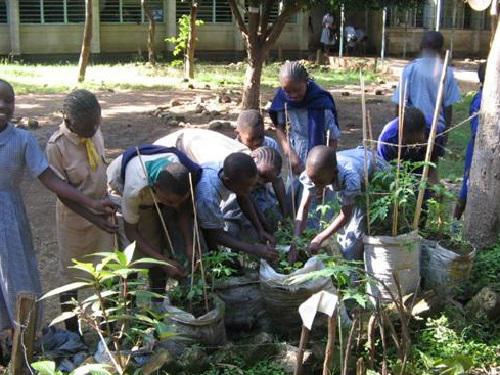Evarastus Obura
Other projects
3 Dec 2014
Integrated Action for Conservation of Dunga Kajulu Ecosystems through Enterprise Development
The goal of this project is to start a sustainable process for Dunga swamp conservation through involving the schools and communities around Dunga wetland in addressing the mentioned problems.

Pupils of Joel Omino school working on the school tree and vegetable nursery set up during the project.
Dunga wetland is one of the wetlands around Lake Victoria and also one of the 60 Important Bird areas in Kenya whose conservation status is classified as urgent thus needing immediate attention (Kenya IBA directory Ben nun and Njoroge 1999). The swamp is located at (010 10’S,340 47’E) in western Kenya, 10km South East of Kisumu city.

Eco finder drama group educating the public during a football tournament.
The swamp stretches south-eastwards along the shores of Lake Victoria for about 5km varying in width from 0.05km and 0.8km. The wetland has the following social, economic and ecological functions:
i. It is habitat to bio-diversity which includes mainly papyrus endemic birds like the globally threatened papyrus yellow warbler, the near threatened papyrus Gonolek, carruther’s cisticola, papyrus canary and white winged warbler( Birdlife International IBA status report 2004) and also the endangered antelope species, the Sitatunga. It is also a very prominent habitat for nesting and rearing of chicks to the endangered African grey crowned crane;
ii. An important habitat and breeding ground for most Lake Victoria indigenous fish species e.g. the lungfish, mudfish and tilapia;
iii. Its buffer/filter of pollution entering Lake Victoria the second largest fresh water lake after Lake Superior in Canada;
iv. It’s potential site for eco-tourism due to its diverse plant and animal species for bird and botany as well as its other aesthetic values.
The problems facing the site include:
i. Unsustainable papyrus harvesting by the locals destroy bird and Sitatunga habitat;
ii. Unsustainable farming in the wetland lead to papyrus destruction through burning and cutting hence destroys several other forms of life;
iii. Ignorance; the locals have not realised the potential for sustainably earning a living through utilizing the wetlands resources. Some cultural habits e.g. associating some birds in the wetland with bad omens have led to many birds being killed especially by the local children;
iv. Local pollution. The proximity of the swamp to Kisumu City puts particular strain on the swamp through pollution in the form of sewage and solid wastes (Nasirwa and Njoroge 1997, Bennun and Njoroge 1999). These problems are compounded by the fact that, the wetland is not under any protection and Kenya is yet to finalize on wetlands development and management policy.
The goal of this project therefore is to start a sustainable process for Dunga swamp conservation through involving the schools and communities around Dunga wetland in addressing the mentioned problems. The goal of this project will be met through the following specific objectives:
i. To enhance awareness on the importance of Dunga swamp and educate the community on sustainable utilization and conservation of the wetland;
ii. To spearhead an implementation process of the issues addressed during the awareness creation in schools through involving the respective schools at all implementation stages;
iii. Capacity building of LVSB members through training in project management and public relations in preparedness to current and future challenges in community mobilization. This is to be done forty days before field activities.